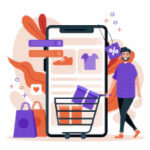In today’s competitive digital landscape, relying solely on organic reach is no longer enough to grow your brand and attract new customers. With so many businesses vying for attention online, paid advertising across digital platforms has become one of the most powerful and effective ways to increase brand visibility, reach your target audience, and boost conversions.
Whether you’re looking to drive traffic to your website, generate leads, or increase sales, paid advertising offers unparalleled targeting options and measurable results. In this blog, we’ll explore how to leverage paid advertising across various digital platforms to boost your brand and achieve long-term business growth.
1. Understanding the Power of Paid Advertising
Paid advertising refers to any form of online promotion where businesses pay to display their ads to a specific audience. Unlike organic marketing, which can take time to generate results, paid advertising provides immediate visibility and is highly customizable. Whether it’s a small business or a global enterprise, paid ads offer a cost-effective and targeted way to reach potential customers.
There are numerous benefits to investing in paid advertising:
- Instant visibility: Your ads can appear on top of search results or social media feeds, increasing your chances of being noticed.
- Precise targeting: Paid platforms allow businesses to target specific demographics based on age, gender, location, interests, and online behavior.
- Budget control: You can set a daily or lifetime budget and adjust your spending based on performance.
- Measurable ROI: Paid advertising platforms provide detailed analytics that help you track and optimize your campaigns for the best results.
2. Choosing the Right Platform for Your Paid Advertising
When it comes to digital advertising, there is no one-size-fits-all approach. Different platforms offer different opportunities, and choosing the right one depends on your business goals, audience, and content type. Let’s take a look at the major platforms where you can run paid ads and their unique advantages:
- Google Ads (Search and Display): Google Ads offers one of the most effective ways to reach users who are actively searching for products or services. With search ads, your brand can appear at the top of Google search results when users type relevant keywords. Display ads, on the other hand, allow you to showcase visually appealing ads across a network of websites and apps.
- Facebook Ads: Facebook is a dominant player in social media advertising, allowing businesses to run highly targeted ads across both Facebook and Instagram. From carousel ads and video ads to retargeting campaigns, Facebook Ads offer flexibility in reaching specific audiences based on their interests, behaviors, and online activities.
- Instagram Ads: As a visual platform, Instagram is perfect for brands that rely on imagery to sell their products. Instagram offers several ad formats, including photo ads, video ads, and Instagram Stories ads. It’s especially effective for lifestyle brands, fashion, beauty, and travel.
- LinkedIn Ads: For B2B companies, LinkedIn is the go-to platform for targeting professionals and decision-makers. LinkedIn Ads allow you to target based on job titles, industries, company sizes, and even specific companies. This makes it ideal for businesses looking to generate leads and build brand awareness among a professional audience.
- YouTube Ads: As the world’s second-largest search engine, YouTube offers massive reach for brands through video ads. Whether it’s pre-roll ads (played before a video) or in-stream ads (played during a video), YouTube allows you to deliver highly engaging visual content to a global audience.
- Twitter Ads: Twitter is ideal for brands looking to capitalize on trending topics and real-time events. With Twitter Ads, businesses can promote their tweets to increase visibility, run promoted hashtag campaigns, or boost engagement with specific audiences.
- TikTok Ads: Known for its viral content, TikTok has quickly become a major player in paid advertising. TikTok’s In-Feed Ads and Branded Hashtag Challenges allow brands to reach younger audiences through creative, fun, and highly engaging content.
Each platform serves different purposes, so businesses must carefully consider their target audience and the platform’s unique strengths when choosing where to invest their ad budget.
3. Creating High-Converting Ads
Once you’ve selected the platform, the next step is to create ads that capture attention and drive results. Paid ads must be engaging, concise, and optimized to convert viewers into customers. Here’s how you can craft high-converting ads across various platforms:
- Catchy Headlines: The headline is the first thing people will see, so make sure it’s clear, attention-grabbing, and relevant to your target audience. Focus on the benefits or solutions your product or service provides.
- Compelling Visuals: Whether you’re using images, graphics, or videos, visuals play a critical role in drawing attention to your ads. Ensure your visuals are high-quality and aligned with your brand’s message. For video ads, keep them short and impactful—5 to 15 seconds is ideal.
- Clear Call-to-Action (CTA): Every ad should have a clear and actionable CTA that tells users what you want them to do next. Common CTAs include “Shop Now,” “Learn More,” “Sign Up,” or “Get Started.” Make sure the CTA aligns with the goal of your campaign.
- Offer Value: Ads that offer value to the viewer, such as discounts, free trials, or exclusive content, tend to perform better. Highlighting what the user will gain by clicking on your ad can increase your conversion rates.
- Optimize for Mobile: Since most users access digital platforms through their mobile devices, make sure your ads are optimized for mobile viewing. This includes using mobile-friendly formats, responsive design, and fast-loading pages for post-click experiences.
4. Leveraging Advanced Targeting Options
One of the greatest advantages of paid advertising is the ability to target specific audiences. Here are some key targeting options available across platforms:
- Demographic Targeting: Target based on age, gender, location, income level, and more. This is useful when you know specific traits about your ideal customers.
- Interest and Behavioral Targeting: Platforms like Facebook and Instagram allow you to target users based on their interests and online behaviors, such as the pages they follow, the content they engage with, or the products they browse.
- Custom Audiences and Retargeting: You can create custom audiences from your website visitors or email lists and serve them personalized ads. Retargeting ads are highly effective for reminding potential customers about your brand after they’ve shown initial interest.
- Lookalike Audiences: This feature allows you to target people who share similar characteristics with your existing customers. By expanding your reach to lookalike audiences, you can discover new potential customers who are likely to be interested in your products or services.
5. Maximizing ROI with Budget Optimization
Maximizing your return on investment (ROI) requires smart budget management. Here’s how to make the most out of your ad budget:
- Set Clear Objectives: Before launching any paid campaign, determine your goals—whether it’s website traffic, leads, or conversions. Clear objectives will help you allocate your budget effectively.
- Monitor Campaign Performance: Regularly track your ad performance metrics, such as click-through rates (CTR), conversion rates, and cost-per-click (CPC). By analyzing this data, you can identify which ads are performing well and adjust underperforming campaigns.
- A/B Testing: Run multiple variations of your ads to see which one resonates best with your audience. Test different headlines, visuals, and CTAs to find the winning combination.
- Adjust Targeting: If a particular audience segment isn’t responding well to your ads, refine your targeting. By continuously optimizing your audience settings, you can improve the relevancy of your ads and reduce wasted spend.
6. Measuring Success and Analyzing Results
Paid advertising provides businesses with a wealth of data to track and measure success. After your campaign runs, analyze the results to understand which strategies worked and where there’s room for improvement. Key performance indicators (KPIs) to monitor include:
- Impressions and Reach: How many people saw your ad?
- Click-Through Rate (CTR): What percentage of viewers clicked on your ad?
- Cost-Per-Click (CPC): How much did you spend on each click?
- Conversion Rate: How many users took your desired action (e.g., purchasing a product, signing up for a service)?
- Return on Ad Spend (ROAS): How much revenue did your campaign generate compared to how much you spent?
By evaluating these metrics, you can refine your future campaigns and achieve better results over time.
Conclusion
Paid advertising across digital platforms is an essential component of modern marketing strategies. With the right approach, businesses can significantly boost their brand visibility, engage with targeted audiences, and drive conversions.
At Do365 Technologies, we specialize in creating customized paid advertising campaigns that deliver measurable results. Whether you’re looking to run Google Ads, social media campaigns, or retargeting strategies, our team is here to help you maximize your digital ad spend and achieve your business goals.
Ready to elevate your brand with paid advertising? Contact Do365 Technologies today to get started!






